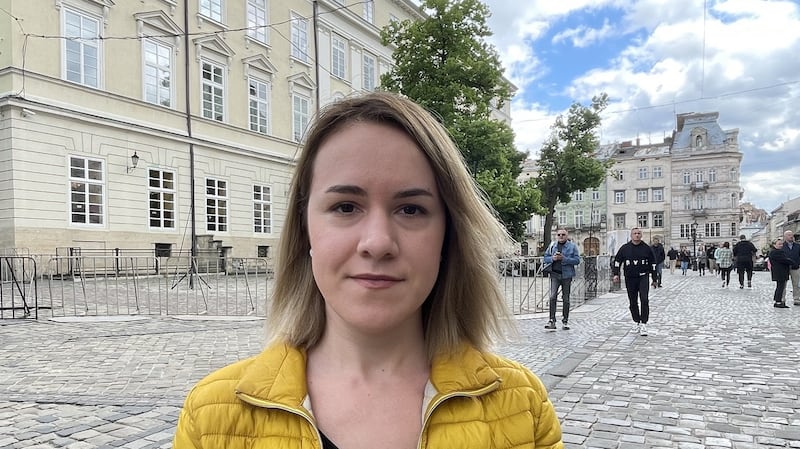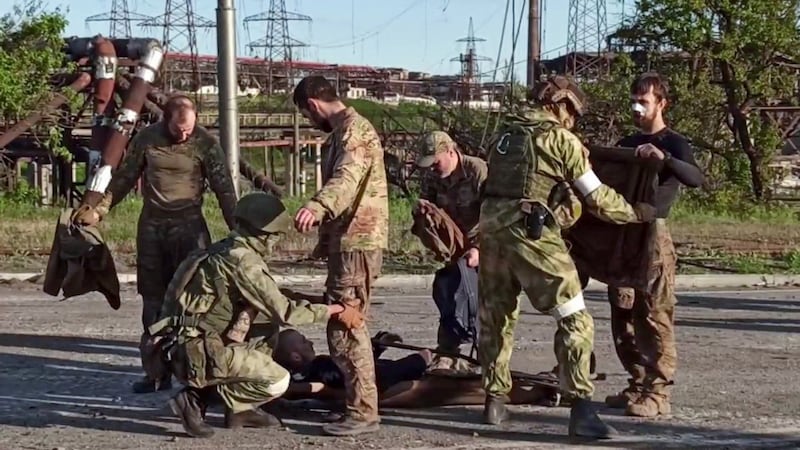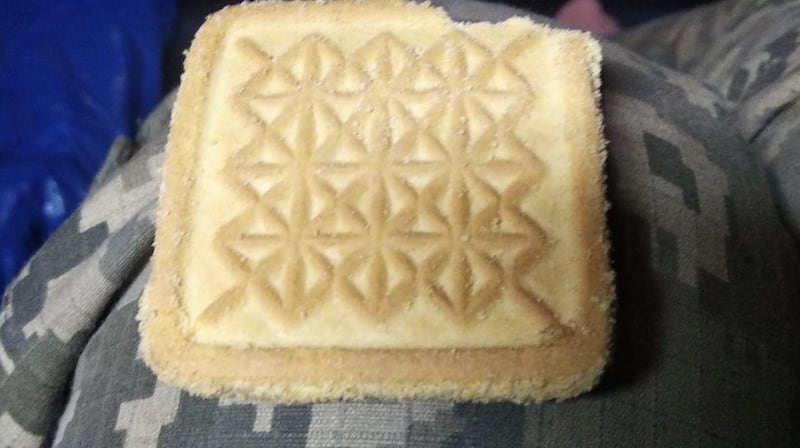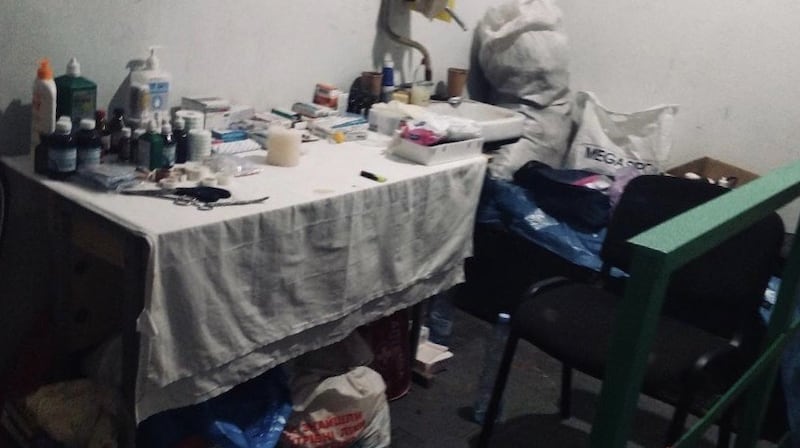A few weeks before Russia launched its full-scale invasion of their country, Lesia took a break from her IT job in Lviv in western Ukraine and travelled to Egypt with her mother Olena, a military nurse.
“When we were walking along the beach one day, she said: ‘Do you think this is my last time here, enjoying the sea?’” Lesia recalls now. “‘What are you talking about Mum, of course not,’ I said, but those words really struck me. And then she went to Mariupol.”
The port city on the Azov Sea was a priority target for Russian president Vladimir Putin’s forces when they poured into Ukraine before dawn on February 24th, starting a full-scale war that has now killed thousands of people and displaced more than 12 million.
“It was my mum who called me that morning, at about 5 o’clock, and told me to take my stuff and go to my father and brother and stay somewhere safe,” says Lesia (31), who only found out weeks later that Olena was in Mariupol from the second day of the war.

Three months on, Lesia thinks Olena (57) must be in Russian captivity along with more than 2,000 other Ukrainian servicemen and women who finally surrendered the vast Azovstal steelworks in Mariupol last week after a hellish siege – but she has heard nothing from her mother since May 7th.
After their holiday, Olena travelled east in late January for her fifth rotation through the Donbas region, where Ukraine has been fighting Russian-led militants since 2014.
Lesia says she was more concerned than usual due to alarming reports from US and British intelligence that Putin was preparing a huge invasion force. “I was 80 per cent sure it would happen and even had a bet with my friends. How I wish that I had lost.”
She drew some reassurance, however, from the fact that Olena serves with the state special transport service, a military unit tasked with protecting Ukraine’s transport infrastructure but not trained for full combat.
Yet Olena’s comrades had to join the desperate defence of Mariupol, formerly home to 400,000 people, as Russia bombarded it from air, land and sea, allegedly killing more than 20,000 civilians, and driving Ukraine’s forces into the labyrinthine tunnels and bunkers of Azovstal, a Soviet-era steelworks that sprawls over 11 square kilometres.
“We had stable contact until March 5th and then we lost contact for two weeks. It was probably the hardest and most nerve-wracking two weeks of my life. We were following the news of all the bombings and everything [at Azovstal] and we didn’t know what was happening or if she was still alive,” says Lesia.
“Then I think someone from the Azov regiment found a spot where they could call, and they passed on word that she was okay.”
The defence of Mariupol and then Azovstal was led by the Azov regiment, which grew out of Ukraine’s ultra-nationalist movement but broadened its membership and distanced itself from politics after becoming part of the Ukrainian national guard.
‘Constant bombing’
Moscow portrays Azov as the epitome of a “neo-Nazi” Ukraine that must be destroyed, however, and prominent Russian politicians have said its members should be treated as terrorists, barred from prisoner exchanges, and even made subject to execution.
“There is no one that I believe and trust more than Azov … because they defended so strongly and my mum said they were the ones who provided them with food and water,” says Lesia, who does not want her family name to be published for fear of jeopardising Olena’s safety.

“There were storage places with supplies in Azovstal, but to reach them, take what was needed and bring them back to people was very risky. There was constant bombing, and a sniper was shooting there. So every time, they were risking their lives. And they didn’t do that just for other military units but for the civilians who were hiding there too.”
Many hundreds of Mariupol residents took refuge in Azovstal as their city was destroyed by a Russian bombardment that flattened schools, hospitals, and a theatre where hundreds of sheltering people are thought to have been killed.
Without sufficient fighter jets or long-range missiles or advanced air-defence systems, Ukraine’s forces were stuck about 100km from Mariupol with no way of ending the blockade, but Kyiv says daring supply missions did take place.
"Helicopter pilots for many weeks were flying there, knowing that 90 per cent do not return ... Imagine what these people did. They flew there to give food, water and weapons to Azovstal defenders and took away the wounded. We lost many pilots. They are absolutely heroic," Ukrainian president Volodymyr Zelenskiy revealed last week.
The factory turned fortress is thought to have maintained contact with the outside world thanks to one of thousands of Starlink dishes that now connect war-damaged parts of Ukraine to the satellite internet service provided by Elon Musk’s SpaceX company.

Lesia thinks a Starlink dish probably reached Azovstal in mid-March, “because then we had a more or less stable connection ... They were not allowed to speak by phone because it was not secure enough, but we could communicate via messages on the Telegram app”.
“Already in late March, she told me very bad things about the conditions – shortages of food, medicines and drinking water. They washed their bodies perhaps once a week with rainwater, and ate once a day, and had the opportunity to go outside maybe once a week for five or 10 minutes, just to take a breath and then go back.”
Gruesome images
At that time, the Russian military was being fought to a bloody standstill outside Ukraine’s two main cities, Kyiv and Kharkiv, prompting the Kremlin to reassess its goals and announce in April that it would focus on “liberating” Mariupol and the rest of Donbas.
“In April the bombing was constant, 24 hours a day. She was very scared because the walls were shaking all the time,” Lesia says of her mum, to whom she gave little tasks to calm her nerves – looking for three red objects or three square things in her subterranean refuge, or taking photos that would tell the story of her time there.
“I tried constantly to reassure her and convince her that everything will be okay, that help is coming, and she believed and trusted me. If one time I didn’t reassure her, she would say ‘Why don’t you tell me this today? Don’t you believe it anymore?’ She held on to my belief, because she and her comrades were losing their own belief.”
Olena looked after about 20 lightly wounded people in Azovstal, but as the bombardment intensified, gruesome images emerged from the besieged plant of soldiers who had suffered severe injuries and undergone surgery in the factory’s makeshift hospital.

Finally, in early May, the United Nations helped broker a series of temporary ceasefires during which civilians were evacuated from Azovstal to Russian-controlled territory, where they were checked in "filtration camps" for links to the Ukrainian military before being allowed to continue to Kyiv-controlled areas.
“Our last contact was on May 7th,” says Lesia.
“Mum said it was pretty much quiet during the day because the evacuation of civilians had started. But at night it continued to be a nightmare, and they were bombing from the air and with all kinds of weapons. She said it was very scary.”
Kyiv told the Azov regiment, marines and other troops to surrender Azovstal last week after successfully defying and tying up a significant number of Russian units for three months, and Moscow announced last Friday that it had full control of the plant.
Ukrainian officials say a deal was reached, with the help of the UN and Red Cross, for the Azovstal troops to return home through a prisoner exchange with Russia; the Kremlin says they will be treated according to international law, but it is not clear that it will class them as prisoners of war, and prominent Moscow politicians have called them terrorists and war criminals who should not be exchanged and could face the death penalty.
“I don’t trust them at all – we are dealing with Russia, which in my mind is a terrorist organisation, and we can expect anything from them,” says Lesia.
“I’m just waiting for my mum to call ... Maybe she wouldn’t tell me the full truth, maybe they will make her tell me something, but from her voice I will be able to tell if she is really okay or not.”
Lesia has been scouring photographs and footage of people captured by Russia at Azovstal, without finding any trace of her mother. A glimmer of hope came from two members of Olena's unit, who contacted relatives to say they were being held in the Russian-controlled town of Olenivka, near Donetsk, and were being treated decently.
“When we talked about it, she said captivity was something she was more scared of than death … So now – when I have no contact with her and don’t know if she is with at least some of her comrades, or is completely alone – it drives me crazy,” Lesia says.
Now she hopes the world will not forget about Azovstal’s defenders, or lose interest in Ukraine as Russia’s invasion grinds on for many months or years.
“We Ukrainians feel this support very much – it is very, very important to us,” Lesia says.
“I passed on to my mum all the words of support that I received … It’s what kept them alive, and kept them believing that they would survive, and that the world would save them.”




















